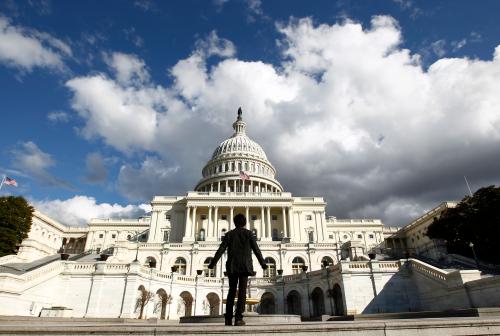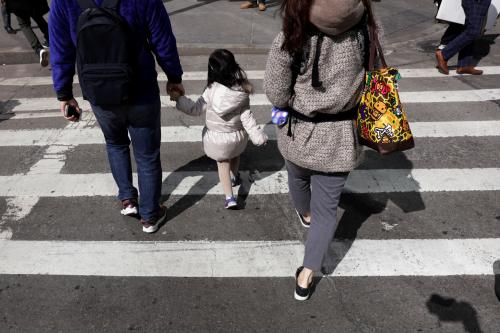It is hardly a secret that income inequality has risen in recent decades. But by how much? Who is most affected? Does it matter? Scholars arrive at different answers to these questions, sometimes because they use different datasets, or apply different methods. Technical decisions—defining households, handling those recording zero income, applying an inflation adjustment, and so on—can make a big difference to final numbers. A particularly tricky issue is whether to include government-provided services, such as Medicaid, in estimates of income, and if so, how to calculate their value.
One of the most robust series on income trends is produced by the Congressional Budget Office (CBO), albeit it with a multi-year delay: the numbers for 2015 were released in November 2018. CBO provides careful estimates of income across the distribution and over time, as well as before and after taxes and transfers. Importantly, CBO takes full account of government-provided health care, which makes a big difference in the results, especially on the lowest income rungs. (See the technical note below for more details on their approach.) CBO presents data for both average income and share of income.
Real income growth high for rich and poor, sluggish for middle class
Since 1979, the households right at the top of the distribution, the much-vilified 1 percent, have seen their incomes rise fastest, more than doubling since 1979 even after taxes:
On this chart, any differences in the remaining 99 percent are harder to see, simply because the left-hand axis has to stretch to accommodate the big rise at the very top. Fortunately, the CBO also provides data for the top quintile minus the top 1 percent (i.e. the 81st to 99th percentiles). This allows us to shrink the left-hand axis and see more clearly what is going on in the bottom 99 percent:
The top quintile has been pulling away from the middle class, even without the top 1 percent in the mix. But not from the bottom quintile, according the CBO. In fact, income growth for the poorest group has been as great as for the upper middle class (79 percent versus 78 percent growth between 1979 and 2015), while the middle class have experienced sluggish growth by comparison (46 percent). As Bob Samuelson points out in the Washington Post, it is simply wrong to claim that has been no increase at all for middle class households—and it is unhelpful when that claim is made. Low growth is better than no growth; but it is still low.
It hardly needs saying that this does not mean all is well for those on the lowest rung of the ladder. These are measures of growth, not level, and 79 percent of not very much is still not very much.
Redistribution from rich helps poor, less so the middle
Income growth is not a zero-sum game. Every income group could see their incomes double over the same time period. In fact, this is pretty much what happened in the decades after World War II. But the CBO also estimates the share of total income going to different groups in the distribution. This is necessarily zero-sum: increasing the share of income going to one group means reducing it for another. It is useful, then, to look at shares before and after taxes and transfers are taken into account:
About half of all income goes to households in the top 20 percent of the distribution. Note, however, that the share of income going to the top quintile drops from 55 to 48 percent as a result of taxes and transfers, while the share for those lower down increases. Redistribution goes some way toward evening out the distribution, although less so in the U.S. than in other nations.
Again, however, the action is mostly at the top and the bottom of the distribution. In relative terms, the impact of taxes and transfers on income share can be seen most strongly for the richest (who lose) and the poorest (who gain). The income share of the bottom quintile almost doubles as a result of taxes and transfers:
The second quintile also sees an increase in income share, though much less dramatic. The overall picture in terms of income share echoes that for real income growth. Affluent households pay taxes to fund transfers and services that have the biggest impact for those toward the bottom of the distribution.
Growing middle-class market incomes
What does all of this mean for improving the incomes of middle-class households? One response to these trends would be to redistribute more toward the middle class rather than just the poor. We have shown in earlier work (see “The rise of the middle class safety net”) that this is already happening to some degree. The many current proposals to enhance tax credits would accelerate this trend. The basic assumption here is that given the sluggish growth in market incomes for middle-class households, the state will have to give them more money. The political disagreement is over who should pay: conservatives typically call for cuts in either anti-poverty programs or entitlements; progressives tend to favor higher taxes on the wealthy.
Certainly providing more direct help to the middle class is an urgent need. But in the long run, redistribution cannot be the primary means for increasing the incomes of middle-class households. Higher market incomes will be needed. That means higher wages, which in turn means a rebalancing of power in the labor market toward workers, and investment in skills to drive up labor productivity. Rather than simply ensuring the middle class gets a bigger slice of the pie, we need to ensure that the middle class can help to grow the pie more quickly; to be the engine of economic growth as well as its beneficiary.
Technical Note
In the CBO data, income percentiles are constructed by ranking households according to their size-adjusted income, before taxes and transfers. A household is defined as all individuals sharing a housing unit. Income is adjusted for household size by dividing by the square root of the number of people in the household. Income before transfers and taxes refers to the combination of market income (labor income, net business income, capital income, retirement income, and other non-governmental sources of income) and social insurance benefits (benefits from Social Security, Medicare, unemployment insurance, and workers’ compensation). Income after transfers and taxes includes income before transfers and taxes plus means-tested transfers (such as Medicaid, SNAP, SSI, and subsidies for Medicare Part D), minus federal taxes (individual income taxes, payroll taxes, corporate income taxes, and excise taxes). Benefits from Medicare, Medicaid, and the Children’s Health Insurance Program are measured as the average cost to the government of providing those benefits. You can read more about CBO’s methodology here.






Commentary
Restoring middle-class incomes: redistribution won’t do
November 20, 2018